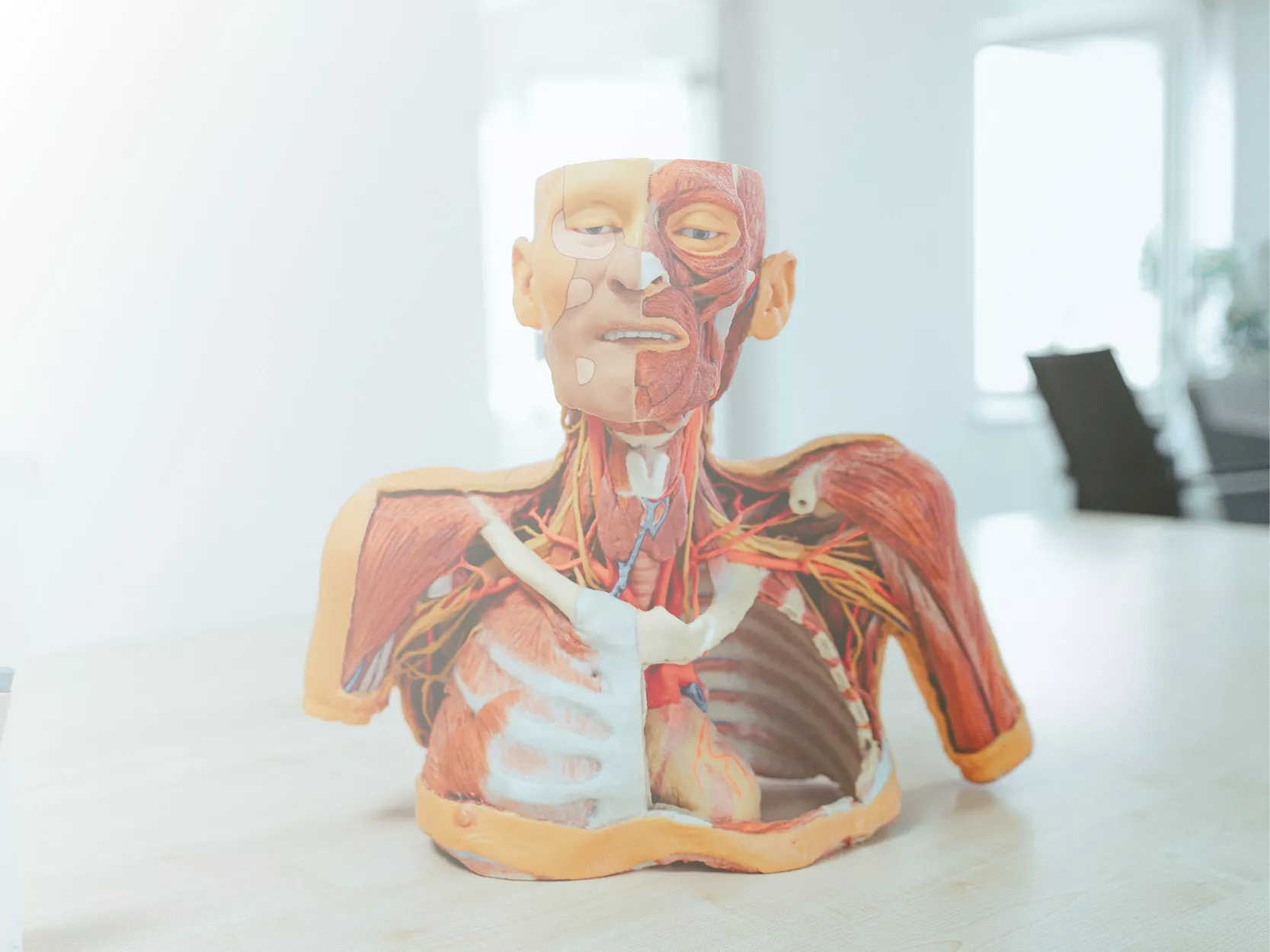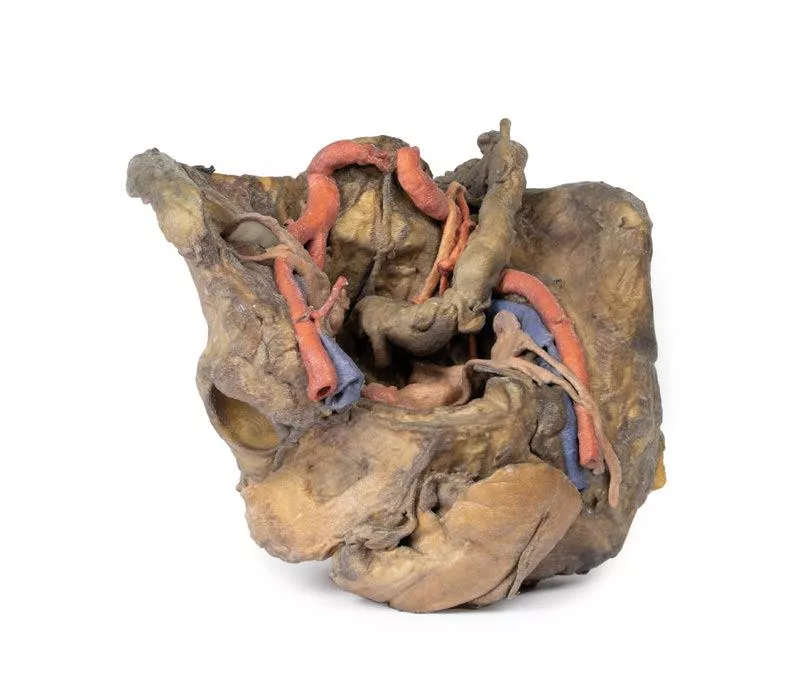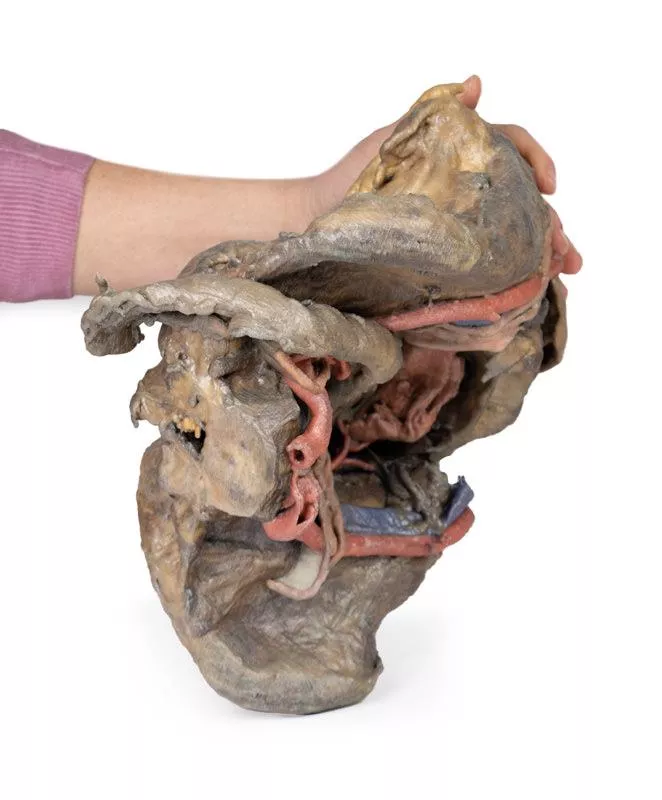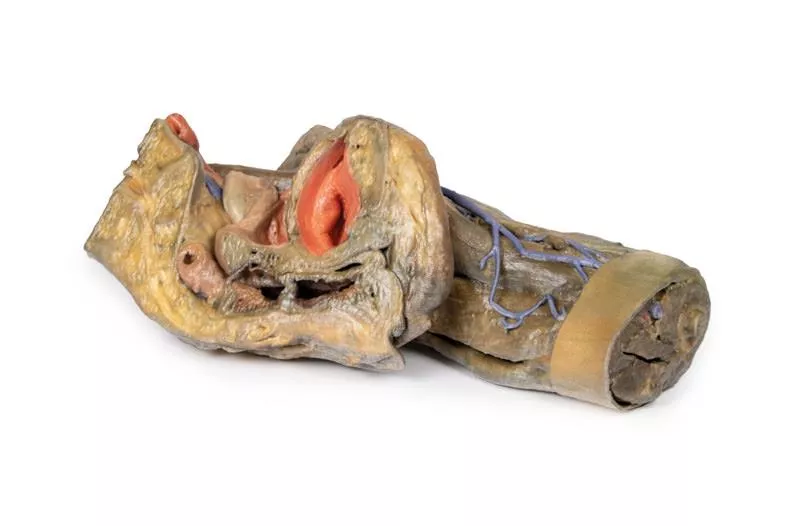Produktinformationen "Female pelvis deep dissection"
Dieses hochdetaillierte 3D-Modell zeigt eine tiefgehende Präparation des weiblichen Beckens, isoliert von den umgebenden Regionen, mit Schwerpunkt auf den viszeralen, vaskulären und ligamentären Strukturen in Bezug auf knöcherne Orientierungspunkte.
Beckenorgane und peritoneale Strukturen
- Der Sigmoidkolon verläuft über den Beckenrand hinunter in das Rektum und kreuzt dabei die gemeinsamen und äußeren Beckenarterien.
- In der Nähe befinden sich die Sigmoid- und die obere Rektalarterie sowie der absteigende Harnleiter.
- Die Harnblase (kollabiert) und die Gebärmutter befinden sich anterior im eigentlichen Becken.
- Das breite Ligament ist erhalten, während die Eierstöcke, Eileiter, Eierstock- und Rundbänder zwar vorhanden, aber aufgrund altersbedingter Atrophie undeutlich sind.
- Das Aufhängeband und das Rundband sind vom Peritoneum abgelöst, um die umgebenden Gefäße freizulegen.
Arterien und Venen
- Die Äste der A. iliaca interna sind beidseitig sichtbar.
- Die A. sacralis mediana ist in der Mittellinie zwischen den A. iliaca communis zu sehen.
- Linke Seite: Nur A. uterina.
- Rechte Seite: A. uterina, A. vesicalis superior und A. obturatoria.
- Die A. epigastrica inferior und die V. epigastrica inferior entspringen aus den A. iliaca externa und sind in der Nähe der unteren Bauchwand sichtbar.
Muskuloskelettale Merkmale
- Rechte Seite: Der gesamte Femur und die Oberschenkelmuskulatur wurden entfernt, um Folgendes freizulegen:
- Die posteriore Dissektion zeigt:
Nerven und Bänder
- Der linke Ischiasnerv ist innerhalb des Foramen ischiadicum magnum erhalten geblieben.
- Das Ligamentum sacrotuberale ist auf der linken Seite erhalten geblieben.
- Die Fossae ischioanalis auf beiden Seiten zeigen:
Beckenorgane und peritoneale Strukturen
- Der Sigmoidkolon verläuft über den Beckenrand hinunter in das Rektum und kreuzt dabei die gemeinsamen und äußeren Beckenarterien.
- In der Nähe befinden sich die Sigmoid- und die obere Rektalarterie sowie der absteigende Harnleiter.
- Die Harnblase (kollabiert) und die Gebärmutter befinden sich anterior im eigentlichen Becken.
- Das breite Ligament ist erhalten, während die Eierstöcke, Eileiter, Eierstock- und Rundbänder zwar vorhanden, aber aufgrund altersbedingter Atrophie undeutlich sind.
- Das Aufhängeband und das Rundband sind vom Peritoneum abgelöst, um die umgebenden Gefäße freizulegen.
Arterien und Venen
- Die Äste der A. iliaca interna sind beidseitig sichtbar.
- Die A. sacralis mediana ist in der Mittellinie zwischen den A. iliaca communis zu sehen.
- Linke Seite: Nur A. uterina.
- Rechte Seite: A. uterina, A. vesicalis superior und A. obturatoria.
- Die A. epigastrica inferior und die V. epigastrica inferior entspringen aus den A. iliaca externa und sind in der Nähe der unteren Bauchwand sichtbar.
Muskuloskelettale Merkmale
- Rechte Seite: Der gesamte Femur und die Oberschenkelmuskulatur wurden entfernt, um Folgendes freizulegen:
- Obturatormembran
- Acetabularknorpel
- Transversales Acetabulargelenkband
- Acetabularknorpel
- Transversales Acetabulargelenkband
- Die posteriore Dissektion zeigt:
- Foramen gluteum superium und Arteria glutea superior
- Ligamentum sacrospinale (mit entferntem Ligamentum sacrotuberale)
- Die untere Rektalarterie verzweigt sich innerhalb der Fossa ischioanalis.
- Ligamentum sacrospinale (mit entferntem Ligamentum sacrotuberale)
- Die untere Rektalarterie verzweigt sich innerhalb der Fossa ischioanalis.
Nerven und Bänder
- Der linke Ischiasnerv ist innerhalb des Foramen ischiadicum magnum erhalten geblieben.
- Das Ligamentum sacrotuberale ist auf der linken Seite erhalten geblieben.
- Die Fossae ischioanalis auf beiden Seiten zeigen:
- Verzweigungen der unteren Rektalarterie
- Fasern des Beckenmembran
- Integration des äußeren Analsphinkters mit der Rektumwand
- Fasern des Beckenmembran
- Integration des äußeren Analsphinkters mit der Rektumwand
Erler-Zimmer
Erler-Zimmer GmbH & Co.KG
Hauptstrasse 27
77886 Lauf
Germany
info@erler-zimmer.de
Achtung! Medizinisches Ausbildungsmaterial, kein Spielzeug. Nicht geeignet für Personen unter 14 Jahren.
Attention! Medical training material, not a toy. Not suitable for persons under 14 years of age.








































